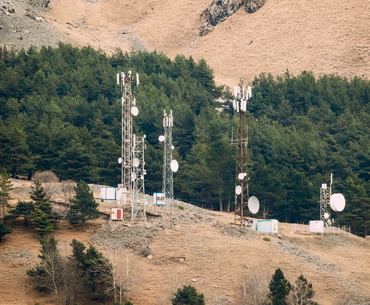
Rental Billing Empowered by Forecasting Model
Optimize Revenue & Higher Returns
The current objectives of tower rental billing encompass accuracy, transparency, efficiency, and adaptability to dynamic market conditions. These objectives are driven by the need to ensure fair and predictable billing for telecom operators, optimize revenue for tower owners, and reduce administrative burdens through automation and advanced forecasting model.
In the telecommunications industry, TowerCo operators face the complex challenge of managing agreements to maximize revenue and ensure higher returns. Determining appropriate lease rate, escalation can be complex due to market fluctuations and varying demand.
Advanced forecasting models have emerged as powerful tools to streamline these processes, providing accurate predictions and enabling data-driven decisions. Integrating machine learning into tower rental billing can significantly enhance accuracy, efficiency, and customer satisfaction.
Though any billing system can adeptly generate invoices based on MISA, apply lease rates and escalations, and calculate late fees and adjustments, a paradigm shift is essential. It's time to transcend traditional boundaries and shift our focus towards 'Beyond Billing', prioritizing the Pre- and Post-Revenue Assurance Processes.
Pre & Post Revenue Assurance Process
360-Degree Financial View
The system should provide a comprehensive 360-degree view of all financial attributes related to the site and tenancy, along with transactional data, all in one place. This includes lease rates, Escalation, Energy charges, and any other relevant financial data.
This integration ensures that data coming from order management and other sources are accurate and properly validated, thereby minimizing errors in the revenue generation process.
MISA Change Identification Process
A Master Infrastructure Service Agreement (MISA) plays a crucial role in the tower rental billing process by defining the lease terms, rate plans, and invoicing mechanisms between the infrastructure provider and the telecom operator or tenant. The agreement includes detailed rate such as base rental fees, additional loading parameters, maintenance fees, energy charges, and any variable charges based on usage.
The system must be capable of highlighting any changes in the Master Site Agreement (MISA) during the invoice generation process to ensure accuracy and transparency. Implement mechanisms to highlight any changes in the Master Site Agreement (MISA) during the invoice generation process. This could involve automated alerts for amendments in lease terms, rental adjustments, or additional charges.
Validation Mechanism & Automated Outlier Detection
Apply stringent validation rules to detect discrepancies before invoicing. This includes checking for missing data, inconsistencies, and anomalies in transactional data. Addressing billing inquiries and disputes is another critical feature to identify the billing patterns and detect anomalies that may indicate billing errors.
The system should automatically identify outliers and cases with high deviation percentages to eliminate any discrepancies or disputes. This automated detection helps maintain the integrity of the billing process and ensures transparency, which is crucial for minimizing disputes and gaining customer confidence.
Dispute Management:
Establish processes for managing billing disputes and discrepancies. This includes tracking disputes, investigating root causes, and implementing corrective actions.
Key Factors:
By focusing on Accuracy, Efficiency, and Transparency, TowerCom can leverage the AI & forecasting model to optimize its billing system and improve customer satisfaction.
Accuracy:
Prioritize data accuracy at every stage of the billing process to reduce errors and ensure reliable revenue generation.
Efficiency:
Streamline pre- and post-revenue assurance processes to improve efficiency and reduce the time spent on manual reviews and dispute resolution. By implementing these comprehensive pre- and post-revenue assurance processes, TowerCo can enhance the reliability and transparency of its rental billing system, thereby improving customer satisfaction and trust.
Scalability:
As your tower portfolio grows, TowerCo’s billing solution can scale with your business. The system is designed to handle an increasing number of tenants and more complex agreements without compromising on performance or accuracy.
Transparency:
Transparency & detailed communication in the billing system is a key factor in minimizing disputes and fostering customer trust.
The Role of Forecasting Models in Rental Billing System
By leveraging these analytical & forecasting technologies, tower rental billing can become more efficient, accurate, and responsive, ultimately benefiting both tower operators and tenants. Forecasting and Machine learning models can analyse market trends, historical data to predict optimal rental rates.
Forecasting model can analyse market trends and usage data to dynamically suggest the rental rates within the parameters set by the MISA.
Combining Tower Rental Billing with a Master Infrastructure Service Agreement (MISA) and leveraging Forecasting model can revolutionize the way telecom infrastructure is managed and billed. Integrating this can further enhance billing efficiency and transparencies, ensuring all services are billed accurately and promptly, thus benefiting both tower operators and tenants.
For tower operators, optimizing rental billing processes is essential for maximizing revenue and achieving higher returns. AI-driven automation, Forecasting models, predictive analytics, and real-time monitoring significantly improve billing processes provide a powerful solution by delivering accurate revenue predictions, enabling dynamic lease rate pricing strategies, apply proper escalation mechanism, and enhancing decision-making processes. By leveraging these models, tower operators can enhance their rental billing operations, achieve financial stability, and gain a competitive edge in the market.
Embrace the power of forecasting models today to elevate your tower tenancy management to new heights of efficiency and profitability.
